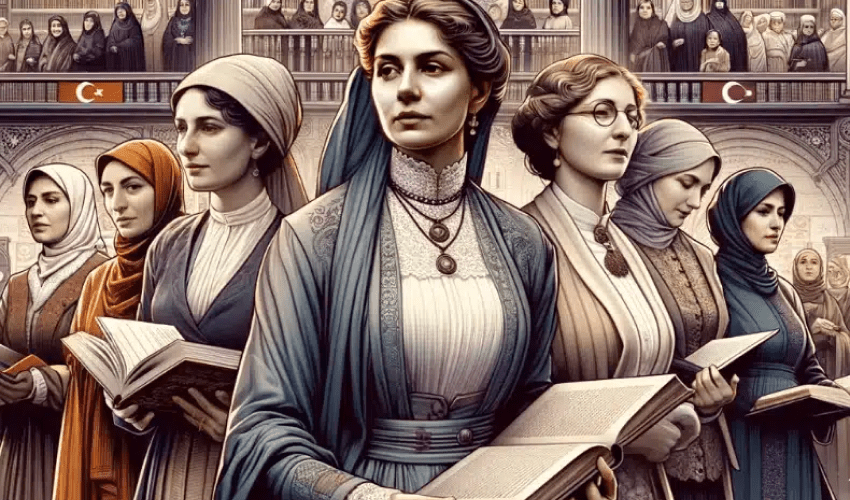Nigar Hanım to Fatma Aliye: The Pioneering Journey of Female Interpreters Through History
Throughout history, the field of interpretation has been graced by the formidable yet often unrecognized contributions of women. These intellectual forerunners faced not only the complex challenges inherent in the art of translation but also navigated the gender norms of their times. From the savvy Nigar Hanım to the scholarly Fatma Aliye, female interpreters have played pivotal roles in diplomacy, cultural exchange, and the evolution of language. This article shines a light on their pioneering journey, tracing their indispensable place in the annals of interpretative history.
- The Greek historian Herodotus notes the presence of female interpreters during the Persian invasions.
- In Egyptian frescos, depictions suggest women engaged in the translation of foreign tongues for pharaoh’s court.
This glimpse into antiquity hints at the foundational but often-unrecognised contributions of female interpreters in the earliest intercultural exchanges.
Nigar Hanım: A Forerunner in the Ottoman Empire
Nigar Hanım, an eminent literary figure, emerged during a time when the Ottoman Empire was undergoing significant transformations. Born in 1856, she defied her era’s gender norms through her prolific poetry and prose. As the first published female poet of the late Ottoman period, Nigar Hanım’s work often grappled with themes of love and feminism, challenging social conventions. Her salon gatherings became a hub for intellectuals, fostering discourse that pushed for modernization and women’s advancement in Ottoman society. Her cultural and literary contributions helped pave the way for future generations of women in the arts and education.
- Prejudices against women’s intellectual capabilities, particularly in fields dominated by men.
- Societal expectations that relegated women to domestic roles, making professional advancement arduous.
- Discrimination within the workplace, including unequal pay and fewer opportunities for high-profile assignments.
Fatma Aliye: Breaking Barriers in the Literary World
Born in 1862, Fatma Aliye Topuz stands as a pioneering figure in the Ottoman literary context. Renowned as the first female Muslim novelist of the Ottoman Empire, her works defied the gender norms of her era. She fiercely advocated for women’s rights through both her literature and personal activism. Fatma Aliye’s literary contributions, which include novels such as Muhazarat, not only opened new realms for women in the field of literature but also challenged societal constraints. She shaped the discourse on women’s roles and education, using her eloquent writing to push against the boundaries set by a male-dominated sphere. Without doubt, her legacy endures as an inspiration for countless women who have since pursued literary endeavours.
- Demonstrated linguistic and cultural competencies rivaling their male counterparts.
- Encountered biases, with extensive scrutiny of their credibility.
- Broke into diplomatic interpretation and literary translation, areas once exclusive to men.
Education and Female Interpreters: The Key to Advancement
Gender dynamics in translation and interpretation have significant historical and cultural implications. Traditionally, the field was male-dominated, however pioneering women like Nigar Hanım and Fatma Aliye have challenged these norms. They navigated gender constraints, shifting perceptions: Demonstrated linguistic and cultural competencies rivaling their male counterparts. Encountered biases, with extensive scrutiny of their credibility. Broke into diplomatic interpretation and literary translation, areas once exclusive to men. Their contributions were instrumental in redefining gender roles within the profession, encouraging a more inclusive environment for subsequent generations of female linguists.
The Influence of Women in Diplomatic Interpretation
Women have trailblazed their way into the realm of diplomatic interpretation, challenging gender norms and impacting global diplomacy. Their linguistic prowess and cultural sensitivity often bridge communication gaps in high-stakes negotiations. Historically, figures like Nigar Hanım and Fatma Aliye opened doors in the Ottoman Empire, wielding their multilingual abilities in service to their country. Today, female interpreters continue to shape diplomatic outcomes, bringing nuanced perspectives and fostering more inclusive international relations. Their influence is a testament to the pivotal role that women have come to play in the delicate art of diplomatic interpretation.
Contributions of Female Interpreters in War and Peace
Female interpreters have played critical roles in shaping wartime communications and facilitating peace processes. Their contributions include:
Breaking Barriers: They provided essential translation services in environments traditionally dominated by men, enabling crucial dialogue between conflicting parties.
- Mobilising Intelligence: With linguistic proficiency, female interpreters often acted as vital sources of intelligence, deciphering intercepted communications.
- Building Bridges: Their multicultural understanding helped forge understanding and empathy, laying groundwork for conflict resolution and diplomatic relations.
- Advocating Peace: They have leveraged their positions to advocate for peace, often at great personal risk, understanding that their work extends beyond mere translation.
Educating and Leading: Post-conflict, many women interpreters engage in educating the next generation and leading reconstruction efforts, emphasising the importance of language in rebuilding societies.
Modern-Day Pioneers: Continuing the Legacy of Nigar Hanım and Fatma Aliye
Modern-day pioneers tread the enduring path of Nigar Hanım and Fatma Aliye, advancing interpretations across evolving societal landscapes. These contemporary figures embrace:
- Digital platforms to reach global audiences
- Inclusion of underrepresented voices in literary and academic discourses
- Advocacy for gender equality in linguistic and cultural spheres
- Interdisciplinary approaches, integrating technology and human insight
Their contributions, embodied in scholarly works and societal initiatives, honour the foundational efforts of their predecessors while charting new frontiers in interpretation.
Future Prospects for Female Interpreters
- For women translators in this century, Fatma Aliye Topuz and Nigar Hanım are not only important figures in history; they are living symbols of courage and rebellion. Their inspiring life stories and the progress they have made have paved the way for many women translators like me. The following are points of inspiration stemming from their legacy:
- Pioneering - Topuz and Hanım challenged the gender role boundaries of their time, providing concrete examples that women could also do impressive work in translation.
- Innovation - Thinking beyond their own time, they introduced new literary genres and translation techniques to Turkish literature.
- Education and awareness - They have shown that being educated and aware is a key weapon in the fight for gender equality.
Their courage is not only an inspiration but also a source of existential strength for women translators of the 21st century.
The Path of Women Translators in Turkey: Yesterday, Today and Tomorrow
The history of women translators in Turkey is full of courageous and determined figures. In the past, names like Fatma Aliye Topuz and Nigar Hanım not only translated literature but also challenged gender stereotypes, paving the way for women's presence in the intellectual sphere. Today, a growing number of women translators play a critical role in a global and multilingual world. Looking to the future, I can see that women translators will benefit significantly from both technological advances and the growing demand for translation, and that their professional paths will expand even further. Despite the challenges they will face along the way, the path for women translators in Turkey looks bright and their contributions can be felt in many fields, from literature to academia.



Comments are closed